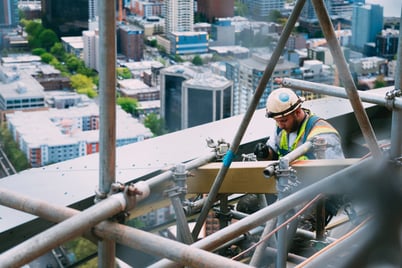
According to NASA's Goddard Institute for Space Studies (GISS), the average global temperature is increasing and though that’s not a good thing at all, it might be worse if you’re in the construction business. Higher temperatures not only throws a spanner at many of your routine constructions tasks but also compromises the safety of workers and operation of heavy machinery.
Taking into consideration these dangers and safety concerns for contractors, we’ve made a list of the key aspects you need to go over to ensure the safety of your workers in hot environments.
1. Heat Exhaustion
Heat exhaustion isn’t just getting tired because of heat, it’s a serious heat-related health condition and can lead to heat strokes if workers continue to work in hot conditions. The condition develops when the body isn’t able to cool itself anymore and the simplest way to avoid this is to take a break. In fact, taking short but regular breaks is your best bet against hot working environments.

As a contractor (or a worker), you should keep an eye out for the following warning signs: workers who are sweating excessively, haven’t taken a break or look dizzy.
Of course, always have plenty of clean drinking water that’s easily accessible on-site.
2. Heavy Machinery
Heavy machinery is expensive, dangerous, and requires maintenance all year round - weather doesn’t change that, but the peak hot days of June and July will ask more than the usual from your machinery. Keeping in mind the extreme working conditions, here are some tips to keep your heavy machinery at optimal working conditions:
- Keep heavy equipment out of the sun, under shade or covered.
- Minimize usage at peak hours (11:00 to 15:00) to avoid overheating and damaging expensive parts like radiators, motors, or even the entire engine. Operating heavy machinery during cooler hours of the day puts less stress on your machine and on your workers.
- Keep a look at gauges and follow safety procedures at all times.
Make sure your operators have water on board and get timely breaks as heavy machinery like skid loaders, tractors, cranes, etc. generally, have closed cabins with limited ventilation making the inside even hotter.
3. Safety Training
You don’t need to spend money or too much time, a 20-minute safety briefing going over the following points will make life a lot easier for workers and operators:
- Have a heavy breakfast in the morning and a lighter lunch, preferably something salty to make up for lost sodium due to sweating.
- Wear light-colored clothing, preferably white to reduce overheating of the body. Lighter fabrics like cotton would also help significantly with this.
- Learn to recognize symptoms of heat-related illnesses like rapid heart rate, vomiting and nausea, cool skin despite the heat, muscle cramps, low blood pressure, and headaches.
- Try to cover as much of the body as possible to protect the skin from harmful UV rays. Wear sunglasses to protect the eyes and sunscreen on exposed skin.
Furthermore, under OSHA law, contractors/employers are required to do many of the things covered in this article including their responsibility to provide clean drinking water, training and educating workers about prevention, emergency procedures, and signs of illness.
4. Know When It’s Too Hot To Work
Sometimes the difference between safety and injury is simply knowing when to stop. We understand the pressure of delivering on deadlines but no deadline is more important than the health of your workers. Additionally, by having your workers work in extremely hot temperatures, you attract serious litigation and government intervention.
According to OSHA’s Heat Illness Prevention Campaign, there are different levels of severity of heat. Here are the three you should look out for:
- 91°F to 103°F: At this stage, you face Moderate risk. You are required to plan ahead, implement precautions, and make sure your workers are aware of the correct working and safety procedures. Moderate Implement precautions and heighten awareness
- 103°F to 115°F: At this level, the risk is High. Additional precautions and safety measures need to be installed. Workers should be given more frequent breaks and monitored for any signs of illness.
- Greater than 115°F: The risk is Very High to Extreme. The most aggressive safety measures should be implemented.
Summers are going to get hot and your best bet to keep yourself, your workers, and your equipment protected to come up with a strategy as a response to the increasingly harsh weather. The above points should be a good starting point for your strategy, you just need to tweak the details according to your business structure, state laws, and environment
Nina Sharpe is a freelance writer specializing in a few niches, including Home & Garden. Writing engaging and high-quality content ranging from interior design and landscape architecture to commercial construction and heavy equipment. Her vice in life is a nice glass of red wine, a great cup of coffee (black), and sandy toes on the beach.
